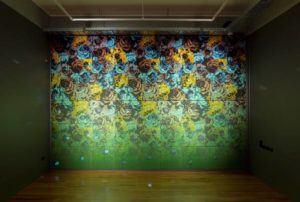16 Apr the pattillo project 2020: dr kathryn wightman, digital parent

Dr Kathryn Wightman, the pattillo project. ‘Digital Parent’ (detail), 2020. screenprinted powdered glass with mirrored glass on glass panels installation with video projection.
For the major new piece created for the inaugural pattillo project Wightman further developed her innovative method which involves screen-printing layers of coloured powdered glass onto sheets of flat glass, then placing them in a kiln to set the layers. The resulting pattern recalls floral designs of vintage wallpapers with reassuring familiarity. The image transitions incrementally with the patterning fading slowly from the top until it becomes uniformly green along the bottom edge, mirroring an algorithmically generated web experience, beginning with the safe and familiar then slowly devolving into the strange, sinister and dangerous. Fragments of YouTube videos are projected onto the work; the platform and its workings unable to be grasped solely through the content of the videos themselves.
Developing further the themes of the work which won her the Open Award at the 2019 pattillo Whanganui Arts Review and the inaugural pattillo project award, Wightman scanned her son and used a 3D printer to produce the forms of his likeness. Forming a totem-esque pole, the candy-coloured shapes are profile sections taken from this scanned data that are then further digitally manipulated. It could speak to the data all of us generate through our online activities which is collected and used for a myriad of purposes.
Artist James Bridle believes we have to critically analyse the structure underpinning a platform such as YouTube and why it creates an incentive for the creation of certain content. This may be easier said than done however as rapidly evolving tools such as artificial intelligence may learn in a way that even its creators may not entirely understand. Nonetheless, ‘Digital Parent’ channels the anxieties about our present media environment and calls for a deeper reflection upon its ramifications.
James Hope
Assistant Curator, Sarjeant Gallery
See more about Dr Kathryn Wightman’s pattillo project in Current Exhibitions’ here

